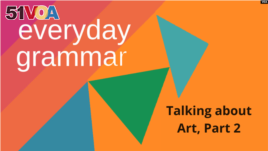After releasing our recent report, Talking about Art, we received many wonderful messages from VOA Learning English fans around the world.
In today's report, we will share some of those messages. We'll provide feedback and suggestions, as well. So, let's hear what you had to say about art and explore some interesting grammar points too.
Dzimitry's message

Let's start with part of a message from Dzimitry.
My favorite piece of art is Over the Town by Mark Chagall. There are 3 most important things for the artist on it: he, his wife and their hometown Vitebsk. Actually, Vitebsk is one of the most wonderful towns in my country Belarus. ... While looking at the art, I clearly understand the feelings of the great artist and fly home in my imagination. This is why I love Over the Town.
Dzimitry provides a good description of the painting, "Over the Town." We have some suggestions to make it even better!
We will start with the second sentence.
You could remove the word "there" as the subject and use a specific noun in its place – for example, "the artwork."
You could also replace the noun "thing" with a more specific noun, like "element." Let's check out the new sentence:
The artwork has three important elements: the artist, his wife, and their hometown Vitebsk.
Or, you could use a different structure, as in:
The three most important elements of the artwork are the artist, his wife, and their hometown Vitebsk.
Dzimitry did an excellent job of organizing sentences. The second sentence ends with the noun "Vitebsk," and then the following sentence gives more details about Vitebsk and Dzimitry's connection to it.
Dzimitry mentioned that he is from Vitebsk and misses his hometown greatly. He says he cannot visit it. We hope that you can do so soon, Dzimitry!
Mariko's message
Now here is part of a message from Mariko.
...I'm Mariko.
I enjoy listening to EVERYDAY GRAMMAR often.
Talking about my favorite art, I'm interested in Claude Monet's Poplars in the Sun.
Its color is brightful but natural because it's illuminated by sun light. I love the green, yellow color of poplars and gentle blue in the sky.
We think Mariko's description of the artwork is excellent.
That said, we have a few ideas on ways to make the piece even better.
The first relates to transitions.
Mariko wrote some words of greeting and then changed the subject to the topic of art:
...Talking about my favorite art, I'm interested in Claude Monet's Poplars in the Sun.
We suggest changing the introduction – "talking about my favorite art." Introductory phrases – especially those that begin with –ing words – can be tricky. It is sometimes a good idea to avoid them.
In this case, a sentence fragment – a sentence without a complete subject and predicate – might work as a transition. For example, you might write some greetings and then change subjects by writing:
A word about my favorite piece of art.
You could go on to add more details. For example:
A word about my favorite piece of art. I love Claude Monet's Poplars in the Sun.
Or:
A word about my favorite piece of art: it is Monet's Poplars in the Sun.
We also suggest removing "brightful" and using the word "bright" instead. You might use the noun "painting" in place of "its," as in:
The painting is bright but natural because it is illuminated by sunlight.
Or you might say,
The painting is bright but natural. It is illuminated by sunlight.
In the final sentence, you might add some determiners such as "the" in a couple places, as in:
I love the green and yellow color of the poplars and the gentle blue in the sky.
There are, of course, different ways to structure such a description. We have only offered a few suggestions.
Closing thoughts
We took some valuable learning materials from today's report. We learned that sometimes including one special noun can help you more clearly express yourself. We also learned about introductory phrases and how to be careful about using determiners such as "the."
Many thanks again for all of your messages. We hoped that you enjoyed writing about art as much as we enjoyed reading your notes. Keep up the good work!
I'm John Russell.
________________________________________________________________
Words in This Story
feedback – n. helpful information or criticism that is given to someone to say what can be done to improve a performance, product, etc.
illuminate – v. to supply (something) with light : to shine light on (something)
poplar – n. a tall, thin tree that has rough bark, soft wood, and very small groups of flowers
introduction – n. an expression or act that presents something new
